
We’ve put together a handy guide to make it simple for you to select sun care, know how often to apply it and how much to use, and the best technique to use to make sure your child is fully protected.
How to pick the best sunscreen for babies and children:
Babies and children have skin that is thinner and more delicate than an adult, which makes it especially vulnerable to sunlight. With this in mind, it’s vital to choose a sun protection product that is not only effective at shielding your child’s skin from the sun’s harmful rays, but also respects your little one’s delicate skin and preserves its health.
Here are some handy tips to follow when selecting a sunscreen for your baby or child:
• It needs to offer SPF50+ and both UVA and UVB protection (broad-spectrum).
• It must be high tolerance which means you need to be looking for words such as hypoallergenic, alcohol-free, paraben-free, and dermatologically tested in the product description.
• Children love to swim and splash around in the pool; therefore, it should be water and sweat-resistant.
• Ideally, it should be visible when applied so that you’re not missing any areas during application (mineral-based SPF products are perfect for this).
• Always check the bottle. A lot of SPFs say that they’re suitable for children, but it’s not one size fits all.
How often should you apply sunscreen on your baby or child?
Unfortunately, you can’t just apply sunscreen to your child once and hope that it will keep them protected all day, SPF doesn’t work like that. For it to be fully effective, you need to be applying it to your baby or child every 2 hours to ensure that they are fully protected. If you find that they are sweating a lot or getting wet (kids just love to run in and out of the pool!) you’ll need to apply it more frequently than every 2 hours, even if the SPF claims to be waterproof.
For the first application, if using a chemical sunscreen, this needs to be done 15-30 minutes before going out in the sun to give the cream the chance to fully absorb into the skin and ideally don’t dress your child while you’re waiting for the product to absorb.

How do you apply sunscreen to a child or baby?
You should apply at least 20 minutes before going outdoors with your little one so that the SPF has a chance to soak into the skin properly.
If you’ve ever tried applying SPF to a wriggling baby or unwilling toddler, you’ll know how difficult it can be; unfortunately, it’s not just that you have to contend with when it comes to sun protection and children. There’s always the underlying fear that you’re not applying it often enough or using enough product, not to mention, applying it correctly.
1. Start at the toes and feet, taking care to apply lotion between their toes and any creases in the skin around the ankle.
2. Concentrate on their torso next, turning them over to cover their backs and paying extra attention to the area that sits just about the nappy because quite often it will move as the day goes on.
3. Next concentrate on their arms and legs, ensuring the lotion is covering every part, even the webbing between their fingers.
When applying SPF to your child’s face the important thing to remember is not to miss parts. Areas of the face that so often get neglected include the eye area (under eye, lids, and the inner corner of your eye socket), ears, neck, and the back of the neck. In order to ensure your application is thorough (and as your child gets older you can teach them the method and make it a fun activity that they will enjoy doing daily!), we recommend the following ESCENTUAL step-by-step guide…
E – Ears (tops and backs)
S – Sides of the face
C – Cheeks and chin
E – Eyelids and under eyes
N – Neck and nose
T – Top of the head and forehead
U – Under your clothes
A – Arms and hands
L – Legs and little toes




